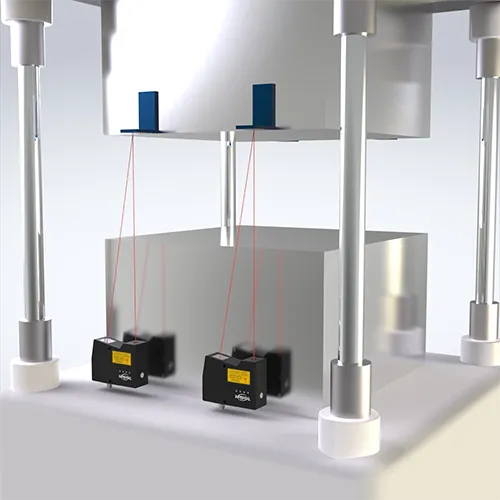AUTO01.Stamping Stroke Measurement with Laser Triangulation Sensors
Aug 29, 2025
1. What It Is & Why It Matters
Stamping stroke measurement refers to monitoring the displacement of stamping press tools during metal forming. Accurate stroke measurement ensures:
-
Production consistency – guaranteeing each part meets dimensional tolerances.
-
Tool protection – detecting abnormal strokes to prevent press and die damage.
-
Process optimization – enabling closed-loop feedback for press automation.
-
Quality assurance – reducing defective parts and material waste.
In high-speed stamping lines, precise and non-contact stroke monitoring is crucial for efficiency, safety, and yield improvement.
2. Common Measurement Methods
| Method | Principle | Advantages | Limitations |
|---|---|---|---|
| Mechanical LVDT sensor | Coil-based linear displacement sensing | Mature, relatively low cost | Contact wear, limited bandwidth |
| Linear encoder | Optical grating displacement detection | High resolution, stable | Sensitive to dust, vibration |
| Laser interferometry | Optical interference of laser beam | High accuracy | Complex setup, costly |
| Laser triangulation sensor | Measures reflection angle shift of laser | Non-contact, high-speed, robust on metals | Accuracy depends on surface reflectivity |
3. Principle & Process of Laser Triangulation Measurement
Laser triangulation displacement sensors measure stamping stroke by:
-
Projecting a laser beam onto the moving press tool or workpiece.
-
Receiving the reflected light with a position-sensitive detector.
-
Calculating stroke displacement based on the triangulation geometry.
-
Tracking motion at high speed for real-time stroke curves.
Key benefits for stamping applications:
-
Non-contact measurement, avoiding wear and impact.
-
High-speed response (160kHz) for fast stamping presses.
-
Micron-level precision (0.02μm repeatability) for detailed analysis.
-
Inline integration, enabling automatic monitoring and alarm functions.
4. TronSight’s Solution

The TronSight TS-P Series Laser Triangulation Displacement Sensor provides a robust solution for stamping stroke measurement:
-
160kHz sampling rate – suitable for high-speed stamping lines.
-
±0.02% of F.S. linear accuracy – ensuring reliable stroke data.
-
0.02μm repeatability – capturing micro stroke variations.
-
Measuring range: 2–2000mm – adaptable to small and large presses.
-
Customizable (laser wavelength, spot size, structural design).
-
Integrated controller – reducing installation complexity.
Application Example (conservative wording):
In stamping lines, TS-P sensors can measure real-time stroke displacement, providing feedback for press adjustment and helping detect stroke anomalies before defects occur.
5. Product Recommendation & Contact
Recommended Product:
👉 TS-P Series Laser Triangulation Displacement Sensor
Key Features:
-
160kHz sampling rate
-
±0.02% F.S. accuracy
-
0.02μm repeatability
-
2–2000mm measuring range
-
Integrated controller
📩 Contact Our Experts
-
Email: service@tronsight.com
-
Phone/WeChat/WhatsApp: +86 13737266828
Recent Posts

October 26, 2016
The Most Successful Engineering Contractor








